Ingrown toenails can be a painful and persistent issue that affects many individuals. Understanding the signs, causes, proper treatment, and prevention methods is crucial for managing this condition effectively. In this blog, We look into specifics of ingrown toenails to provide you with valuable insights for a pain-free and healthy life.
Signs of Ingrown Toenails
Identifying ingrown toenails early is essential for prompt intervention. Pain and tenderness along the sides of the toenail, redness, and swelling are common signs. As the condition progresses, you may notice the development of pus or drainage, indicating infection. Keep a vigilant eye for these symptoms to address ingrown toenails before they worsen.
Causes of Ingrown Toenails
Understanding the root causes of ingrown toenails is key to preventing their recurrence. Tight-fitting shoes, improper toenail trimming, and genetic predispositions are primary factors. Additionally, injuries to the toe or repetitive trauma, such as stubbing, can contribute to ingrown toenails. Recognizing these causes empowers you to take proactive measures.
Treatment Options
1. Warm Soaks
Soaking your affected foot in warm water can help alleviate pain and reduce inflammation associated with ingrown toenails. Add a tablespoon of Epsom salt for enhanced soothing effects.
2. Proper Toenail Trimming
Trimming your toenails straight across, and avoiding rounded edges, can prevent ingrown toenails. If you’re uncertain about proper trimming techniques, consider seeking professional assistance.
3. Antibiotics
In cases of infection, antibiotics may be prescribed to combat bacterial growth. Ensure to complete the entire course as prescribed by your healthcare provider.
4. Surgical Intervention
Severe cases may necessitate a minor surgical procedure to remove the ingrown portion of the toenail. Consult with a podiatrist for personalized advice.
Prevention Strategies
1. Choose Comfortable Footwear
Opt for shoes with adequate toe space to prevent compression and promote proper toenail growth. This simple adjustment can significantly reduce the risk of ingrown toenails.
2. Regular Foot Inspections
Conduct routine checks of your feet, paying attention to any early signs of ingrown toenails. Early detection allows for timely intervention, preventing complications.
3. Maintain Good Toenail Hygiene
Practice proper toenail hygiene by trimming nails straight across and avoiding overly tight footwear. This simple routine can be instrumental in preventing ingrown toenails.
Seeking Professional Help
Seeking advice from an experienced medical practitioner, like renowned podiatrist Dr. Chetan Oswal, is highly recommended if you are experiencing chronic pain or notice any indications of infection. Dr. Chetan Oswal’s quick intervention skills can prevent future problems and ensure the best possible care for your feet.
In conclusion, under Dr. Chetan Oswal’s expert care, understanding the subtleties of the symptoms, causes, available treatments, and preventive measures for ingrown toenails becomes crucial. With the help of Dr. Oswal’s professional advice, you can easily incorporate these practices into your daily routine to reduce the risk of ingrown toenails and to enjoy a pain-free life.





